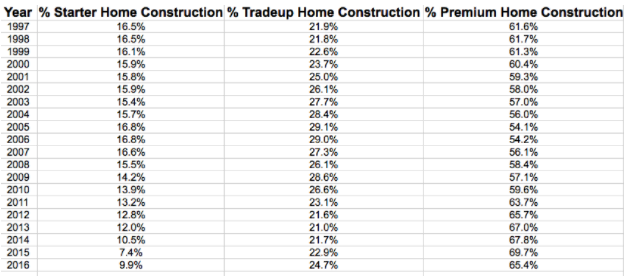5 US cities where you can actually buy new, affordable homes
Americans can’t buy the homes they want because of tight supply and sky-high prices. Where can young professionals looking to settle down actually find homes to buy?
In an exclusive report with Trulia, Yahoo Finance assessed where exactly new and affordable homes are being built across America.
First, Trulia classified homes into three different categories — startup, tradeup or premium. For each of the urban areas, chief economist Ralph McLaughlin said his team assessed all home value estimates — not just those that end up selling. Any home that fell in the bottom third price bracket is a starter home; the middle bracket is a tradeup home; the top bracket is a premium home.
For example, in the New York metro area, a starter home is anything valued under $400,000. The cutoff points are set for every year and every metro.
By calculating the difference between the percentage of starter homes built post-recession (2010-2016) and the percentage of starter homes built pre-recession (1997-2007), Trulia ranked America’s 101 largest metros based on which saw the greatest increase.
Where are starter homes being built?
Thirty-five percent of all new homes being built in Ventura, Calif. are starter homes, a whopping 22% increase from its pre-recession levels (13%). It is also the only metro area that saw a double digit swing between pre- and post-recession periods.
McLaughlin said he’s surprised that Ventura experienced the biggest increase, given how costly California land is. But he but pointed out that it’s an affordable commuter suburb of Los Angeles.
“As home prices have gotten less and less affordable in Los Angeles, people are seeking options outside of the city,” he explained.
New Orleans, La.; Little Rock, Ark.; Cleveland, Ohio, and Richmond, Va. round out the top five regions where starter home construction has been on the rise.
What do these cities have in common? Besides the No. 1 spot, all are southern and midwest markets. All are fairly business friendly, have significant buildable land, and have relatively loose local and state regulations that don’t burden builders, said McLaughlin.
There are city-specific factors too, of course. New Orleans, for example, has recovered after the devastation caused by Hurricane Katrina during the end of the pre-recession period.
“It was cheap and necessary to develop afterward because the land was so devastated afterward,” he said.
The big picture
The proportion of starter homes being built across the country has dwindled significantly. 2015 and 2016 saw the lowest and second lowest levels of starter home construction in two decades, and it has been part of a trend we’ve seen over the last 10 years.

“When builders started ramping up from one of the worst recessions in history, they were probably thinking, ‘Let’s shoot for the higher end because it’s more of a slam dunk.’ They want to build for a market where there’s sure demand,” McLaughlin said.
We commissioned this data because we were curious to find out where buyers could access new homes at the lowest price point. As young adults start to think about homeownership as a near-term goal, it’s important to identify which markets have new homes.
Pre-recession, about 15%-16% of all homes being built were starter homes. Last year, 9.9% of all homes built in the US were starter homes vs. 65.4% premium homes and 24.7% tradeup homes.
Regardless of what kind of home you’re building, there are certain fixed costs related to regulation and land use that are unavoidable, he said. Therefore, the incredible low margins make building starter homes less attractive to begin with.
Though new home sales only represent 10% of all home sales across the country, it’s a good gauge of whether there are new livable homes for millennials who might finally be ready to settle down. New homes help homeowners avoid doling out money on upkeep and renovation (which is an incredible drain on time and resources as well).
The biggest declines in starter home construction
Sixty-nine metro areas saw a decrease in starter home construction. Of the five metro areas that experienced the largest percentage point drop between starter homes built pre-recession and post-recession, four are in Florida: Sarasota, Fort Myers, Daytona Beach and Miami.
“These are places that boomed and busted pretty hard. When lending was laissez faire, money was being pumped into places where investors thought there were going to be future price increase — across fast growing markets like Florida, Texas, Arizona and Nevada. Those places were ones that were flirting with severe bubble territory prior to the recession,” said McLaughlin.
But perhaps the most salient factor is that homes that were foreclosed upon most during the recession were the cheaper homes.
“A large excess of supply coming out of the recession were starter homes. There simply wasn’t demand for starter homes because tons of foreclosed homes were lying around. Even if they did build, they wouldn’t be able to sell them,” he said.
Melody Hahm is a writer at Yahoo Finance, covering entrepreneurship, technology and real estate. Follow her on Twitter @melodyhahm. Contact Melody at [email protected] for more information on the data.
Read more: